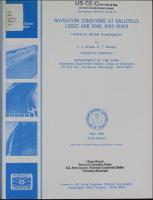Please use this identifier to cite or link to this item:
https://hdl.handle.net/11681/13545Full metadata record
| DC Field | Value | Language |
|---|---|---|
| dc.contributor | United States. Army. Corps of Engineers. Huntington District | - |
| dc.contributor.author | Shows, Louis J. | - |
| dc.contributor.author | Wooley, Ronald T. | - |
| dc.date.accessioned | 2016-08-18T19:13:54Z | - |
| dc.date.available | 2016-08-18T19:13:54Z | - |
| dc.date.issued | 1989-05 | - |
| dc.identifier.uri | http://hdl.handle.net/11681/13545 | - |
| dc.description | Technical Report | - |
| dc.description | Abstract: Gallipolis Locks and Dam, located on the Ohio River approximately 279.2 miles below Pittsburgh, PA, is one of the original 46 locks and dams provided for navigation. The capacity of the existing locks and their approaches are inadequate for present and projected traffic. Alternatives considered for the improvement of conditions included the construction of either one 1,200-ft lock, one 1,200-ft lock and a 600-ft lock, or two 1,200-ft locks in a canal bypassing the existing structure, with and without the use of the existing locks with some improvements; and a complete replacement structure with two 1,200-ft locks about 3 miles downstream. Two fixed-bed models constructed to scales of 1:120 were used to study navigation conditions at the existing site and at the replacement site. The model studies indicated that conditions at the existing site would continue to be difficult and hazardous for downbound tows using the existing locks although some improvements could be made. Satisfactory navigation conditions could be developed with one or two locks in the bypass canal at the existing site, and provisions could be made for two-way traffic under most conditions with two locks in the bypass canal. Navigation conditions for downbound tows approaching the locks with the replacement structure (alternate site) would tend to be difficult and hazardous with the plan as originally proposed because of the alignment of the right bank upstream and the alignment and high velocity of currents approaching the locks. A satisfactory plan was developed by shifting the structures downstream, rearranging the lock auxiliary walls, and modifying the excavation of the adjacent (right) bank. NOTE: This file is large. Allow your browser several minutes to download the file. | - |
| dc.publisher | Hydraulics Laboratory (U.S.) | - |
| dc.publisher | Engineer Research and Development Center (U.S.) | - |
| dc.relation | http://acwc.sdp.sirsi.net/client/en_US/search/asset/1030544 | - |
| dc.relation.ispartofseries | Technical report (U.S. Army Engineer Waterways Experiment Station) ; HL-89-10. | - |
| dc.rights | Approved for public release; distribution is unlimited. | - |
| dc.source | This Digital Resource was created from scans of the Print Resource | - |
| dc.subject | Gallipolis Locks and Dam | - |
| dc.subject | Navigation | - |
| dc.subject | Hydraulic model studies | - |
| dc.subject | Hydraulic structures | - |
| dc.subject | Hydraulic models | - |
| dc.subject | Ohio River | - |
| dc.subject | Replacement locks | - |
| dc.subject | Design | - |
| dc.subject | Evaluation | - |
| dc.title | Navigation conditions at Gallipolis Locks and Dam, Ohio River : hydraulic model investigation | - |
| dc.type | Report | en_US |
| Appears in Collections: | Technical Report | |
Files in This Item:
| File | Description | Size | Format | |
|---|---|---|---|---|
| TR-HL-89-10.pdf | 21.26 MB | Adobe PDF |  View/Open |